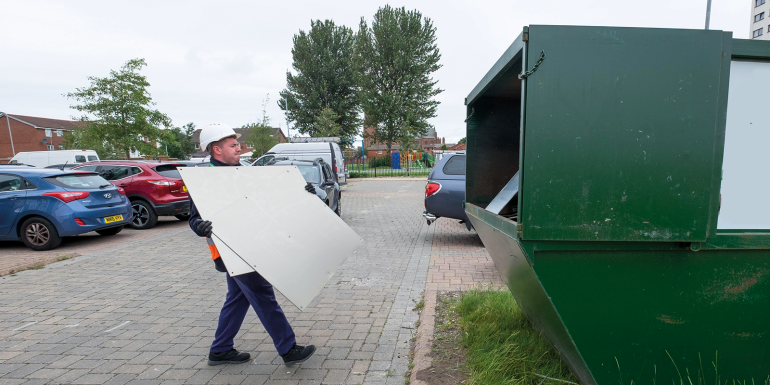Can we get better at managing waste materials?

Charles Creed, Design Co-ordination Manager at Façade Remedial Consultants (FRC), part of the RSK Group, explains how we can better manage waste cladding materials.
The need to remediate unsafe cladding is a priority across the building sector. As we head towards 2050 net-zero targets, there is an increasing recognition that waste resulting from remediation must be handled in an environmentally conscious way. Incoming regulation such as the biodiversity net gain (BNG) legislation, expected to be in force from November, means it is no longer a choice to go further in waste management, but a necessity. As part of the Environment Act 2021, developers will be required to mitigate their impacts on ecosystems and greater emphasis will be placed on reducing carbon footprints. Alongside the Royal Institute of British Architects (RIBA) 2030 Climate Challenge, the sector is making strides towards a more sustainable future.
Reuse
Materials such as brick, timber and mineral wool are resources that can be easily reused in other projects, such as community gardens for paths, sheds and planting. There are many options to reuse these materials, diverting them away from waste streams and reducing the carbon footprint of creating them.
Repurpose
Up a level, metals such as steel and aluminium can, in most instances, be repurposed. Processing these metals via smelting results in new raw materials. For example, slag produced in the process can be mixed with concrete to reduce the overall carbon footprint of a new material. It’s estimated that carbon capture and utilisation technologies such as this may contribute 60% of the carbon saving needed to reach carbon-negative concrete production by 2050.
Refine
The last level, which poses the greatest challenge, is how to manage more problematic materials that cannot be reused or repurposed effectively yet, such as plastics. Most remain destined for landfill. A move towards recycling, whether mechanical or chemical, is part of a larger strategy to reduce waste and protect the environment.
For example, fixings for cladding often change as products develop and are no longer available at the time of remediation. Once removed, a cladding system cannot be remediated safely without the proper fittings. However, the originals can be replicated with recycled plastic using 3D printing technologies. The replaced fittings can be significantly more durable, thermally efficient and non-combustible when properly tested, enabling cladding panels to be reinstalled, rather than wasted.
Across the industry, the way we plan project delivery and site work and manage the material process will have an impact on reducing carbon footprints. Taking action in our areas contributes towards sustainably managing cladding waste now and into the future.
Charles CREED is a RIBA Chartered Architect and Design Co-ordination Manager at FRC, a specialist façade risk consultancy based in the UK. Charles has 25 years of industry experience in design and technical management roles on- and off-site.
For more, visit frconsultants.co.uk






